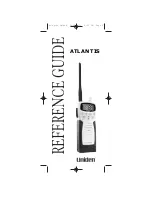
30119-41 Rev. 1.6/02-07
6
50 VDC applied), it should not exceed 21.00 mA.
High loop current can also be caused by a short in
the transmitter hookup cable. A zero Ohm short will
cause power supply fuse to blow. However, it is pos-
sible to have a shunt of about 0.5W to 10W connecting
transmitter lines, which will cause excessive loop cur-
rent with transmitter in system (from 70.0 - 350 mA or
more), but when TR28-2 is tested separately it works
fine. These shorts are difficult to find. They can be
caused by incorrect wiring installation or damage to
wiring. Damage can be caused by physical contact
(back hoe, etc.) or from environmental effects (water in
the raceways).
C.
If transmitter output remains at 4.0 mA even
when the meter and sensor are operating properly, the
TR28-2 must be replaced.
If the loop current is within a satisfactory range,
3.90 mA to 21.00 mA, and varies with a varying flow
rate, but is not showing desired values, the unit can be
programmed with different totalizer, rate scale, zero mA
value, and full scale mA value. (See Programming Guide,
Literature #30110-17.)
X. INSPECTION
and field testing has been accomplished
at this point. Should any of the parts, upon inspection,
appear to be damaged, they must be replaced to ensure
proper operation and prevent further damage.
XI. REASSEMBLY
is necessary at this point. Before reas-
sembling, make certain that the unit is cleaned of any
dust or dirt. Costs for replacement parts not covered
by warranty are available by contacting the factory.
BEFORE RETURNING TRANSMITTER TO FACTORY,
please notify McCrometer. Each unit must be properly
packaged to prevent damage to the product during ship-
ment. Should any of the unit's parts, upon inspection,
appear to be damaged, they must be replaced to ensure
proper operation and prevent further damage. Costs for
replacement parts not covered by warranty are avail-
able from current parts and price list. Should the unit
require further inspection, it must be reassembled and
returned to the factory.
XII. PROCEDURES FOR CHECKING OUT
INOPERATIVE INSTRUMENT SYSTEMS:
Each instrument is factory-tested with the transmitter
that will be operating it. When an instrument doesn't
operate and is connected to its proper transmitter, cer-
tain procedures need to be followed to determine where
and what the problem is. Most troubleshooting proce-
dures are part of each instrument and transmitter ser-
vice manual, but these suggestions may help.
1. CHECK ALL INSTRUMENTS AND TRANSMIT-
TERS
for obvious visual damage. Make certain any
necessary grounding has been made.
2. CHECK YOUR INSTRUMENT
to be sure it is op-
erating properly by following the instrument service
manual. Check to be sure your instrument is operating
correctly when a simulated signal is put into it.
WARNING:
Circuit to transmitter must be disconnected
when most testing equipment is used for checking your
instrument. If instrument checks out, proceed with
checking transmitter and communication lines.
3. WHEN THE TRANSMISSION OR COMMUNICA-
TION LINE
is suspected of being the reason the system
is not functioning, it is usually easier to check the trans-
mitter first to be sure it is giving proper
output. There
are some easy troubleshooting techniques for checking
mA output. First, you must know what mA signal is
expected from the transmitter.
A.
Model TR28-2 current transmitter has
an output of 4 to 20 mA at maximum scale of the
instrument it operates.
B.
The original purchaser of the equipment
should have invoices or other paperwork to confirm
what the 4 to 20 scale is. If not, contact the factory
with the meter serial number and the factory will pro-
vide the full scale information.
C.
Let us assume you found the meter was
a 12" meter and the full scale of the instrument is
3,000 GPM.
4. FULL SCALE OUTPUT.
Once the output at full
scale has been determined, we need find out what the
unit is measuring at.
A.
Time the transmitter totalizer with a
stopwatch for 3 to 5 minutes, to give the best resolu-
tion or closest accuracy.
B.
The example meter has a 1,000 gallon
totalizer and, if you time the totalizer for three counts
in 150 seconds, proceed as follows:
150 sec ÷ 3 = 50 sec for 1,000 gallons (1 count)
C.
To find the true flow rate:
60 sec ÷ number of sec per count x totalizer dial
(or as shown below)
60 ÷ 50 x 1,000 = 1,200 GPM true flow rate
Now verify the indicator is accurate.
D.
To determine what output the transmit-
ter should be sending, we must now find what percent
1,200 GPM is of the 3,000 GPM scale stated earlier.
1,200 GPM ÷ 3,000 GPM = 40%
Because 4 mA equals ZERO it must be subtracted from
20 mA.
Therefore, 20 - 4 = 16 mA usable output (SPAN)
40% x 16 mA = 6.4 mA then add 4 mA back to give
10.4 mA @ 1,200 GPM.
E.
The 4-20 mA current signal can be
checked by using a digital multimeter. Have the multi-
meter set to measure milliamps. With no water flowing
through the meter, the ammeter should measure 4.0
mA. If water is flowing through the meter, the current
level should be between 4 to 20 mA.
NOTE:
A.C. power should be removed from circuit be-
fore inserting the multimeter. The multimeter must be
connected in series with circuit being tested.
5. TRANSMITTER COMMUNICATION LINES (#13)
should be checked to determine if the pulse output is
present.
WARNING:
A.C. power should be disconnected to the
instrument prior to any work taking place on the wiring.































